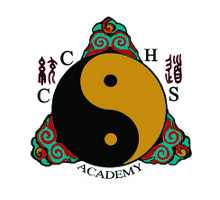Academy of Chinese Culture and Health Sciences
 | |
| Type | Private Nonprofit Graduate Institution |
|---|---|
| Established | 1982 |
| President | Dr. Wei Tsuei |
| Vice-president | Phillip Tou |
Academic staff | 35 |
| Students | 112 |
| Location |
Oakland, CA, United States 37°48′25″N 122°16′22″W / 37.806848°N 122.272900°WCoordinates: 37°48′25″N 122°16′22″W / 37.806848°N 122.272900°W |
| Campus | Urban |
| Affiliations | Accreditation Commission for Acupuncture and Oriental Medicine (ACAOM) |
| Website |
www |
The Academy of Chinese Culture and Health Sciences, established in 1982, is a private, nonprofit graduate institution located in Oakland, California.[1] The school was the first in Oakland and the second in the United States to offer education in Traditional Chinese Medicine, or TCM.[2] Also, the school is the third oldest school in the county to offer education in TCM.
History
In 1982, Master Wei Tsuei (1926–2010) was a practitioner of Traditional Chinese Medicine, Tai chi meditation, and Qigong. At the time, he operated the Taoist Center, which was a nonprofit organization focused on educating people about Taiji, TCM, Tai chi, and Qigong. He founded the Academy with a goal of educating the Western (American) world about the Chinese culture, as well as these philosophies, in order to close the gap between the two cultures.
The academy was located in downtown Oakland until the 1989 Loma Prieta earthquake damaged the building. The Academy was then moved to the current location.
In 1991, the Academy was approved by the California Council as a degree-granting graduate institution and in 1992, the Academy was accredited by the Accreditation Commission for Acupuncture and Oriental Medicine (ACAOM). The Academy was reaccredited in 1997, 2001, and 2004.
Academics
The two main programs offered are the Master of Science in Traditional Chinese Medicine and the Tui Na Massage Therapy Certificate Program. The programs are offered in English and Chinese.[3]
MS in Traditional Chinese Medicine
The MS in TCM is a four-year professional degree program. The program provides students with classroom instruction, clinical internships, and scientific research in order for students to become certified in TCM. The concepts of study include acupuncture, acupressure, herbal medicine, and Tai chi. During the program, students take the National Acupuncture Board Certification Exam.
Tui Na Massage Therapy Certification Program
The Tui Na Massage Therapy Certificate Program is a 250-hour or 500-hour program that focuses on massage and acupressure techniques. Tui Na is a 2000-year-old external medicine therapy and is one of the three pillars of TCM. The term translates to "push and grasp" or "finger and thumb pressure". It is a type of medical massage used to treat injuries, joint and muscle problems, and internal disorders. The goal of the program is for students to become certified to practice Tui Na on patients.
Clinic
The purpose of the clinic at the Academy serves three purposes. The first is to provide traditional Chinese health care, the second is to serve as a teaching clinic to its students, and the third is to advance the field of TCM.[4]
The practitioners in the clinic practice Traditional Chinese Medicine, acupuncture, herbal medicine, Tai chi, Tui na massage (acupressure), Food Therapy, Moxibustion, and Cupping Therapy.[5]
Treatment techniques
Traditional Chinese Medicine
Acupuncture
Tai chi
Tui Na Massage (Acupressure)
Food therapy
Moxibustion
Cupping Therapy
References
- ↑ "Academy of Chinese Culture and Health Sciences". Acupuncture Today. Retrieved 20 July 2013.
- ↑ "History". acchs.edu. Retrieved 1 January 2013.
- ↑ "Programs". acchs.edu. Retrieved 1 January 2013.
- ↑ "Clinic". acchs.edu. Retrieved 1 January 2013.
- ↑ "Treatment Techniques". acchs.edu. Retrieved 1 January 2013.